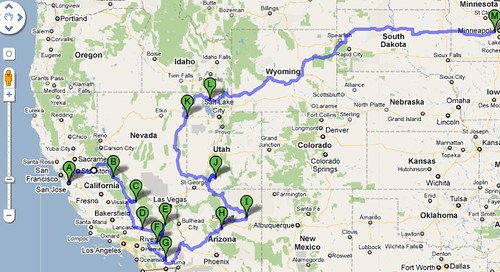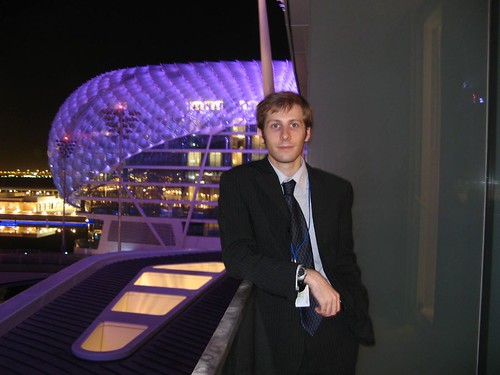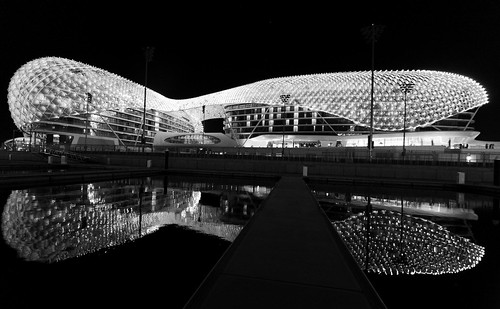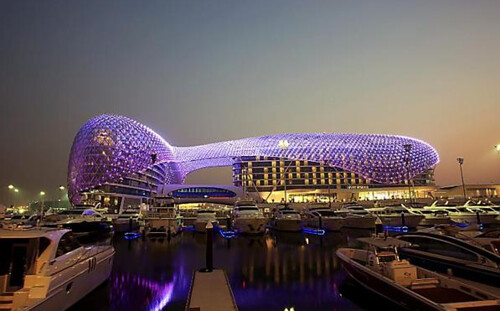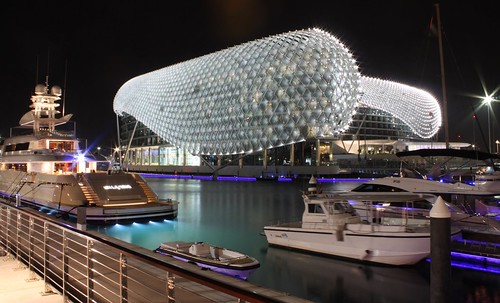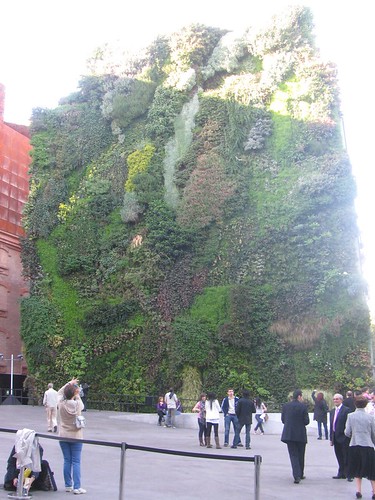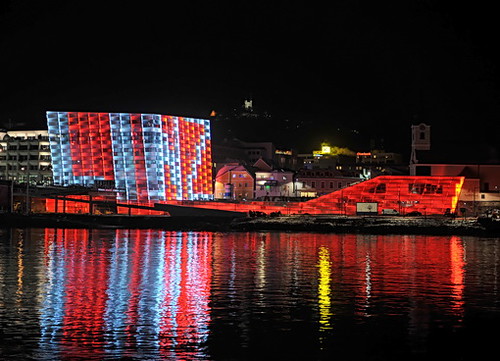Media facades Europe
It would be great to have some U.S. cities as part of this Connected Cities experiment.
Today’s question – What is your dream for the future?

"Hello world, goodbye San Jose," from Christopher Baker, offscript, 300 Santana Row, San Jose, CA Today's question - What is your dream for the future? Commissioned by ZER01 for the 01SJ Biennial
I’m heading home after an amazing 01SJ Biennial. What should I see on the way?
Sky blue night

Leo Villareal, Sky (Tampa). via Public Art Network
Yas hotel
According to Inhabitat,
“created by Asymptote Architecture with lighting design by Arup, The Yas Hotel is a wrapped with a sparkling shell composed of more than 5,300 diamond-shaped panels bristling with over 5,000 LED fixtures. The curvilinear field of lights is capable of running color-changing light sequences and can even display low-res three-dimensional videos.”
So far the images of the Yas Hotel seem like a pretty small official set. Here are some others from a quick scan of flickr.
Dec. 15, 2009, Rory Steele
manuela.martin, Yas Hotel (II), Dec. 5, 2009
Brawnfan, Yas Hotel Yas Marina Circuit, October 30, 2009
The Gorn, Yas Hotel, November 6, 2009
Open Up workshop
Open Up
Medialab-Prado
Plaza de las Letras (Alameda, 15)
28014 Madrid, Spain
Phone: +34 914 202 754
Contact: Nerea Garcia
difusion@medialab-prado.es
http://www.medialab-prado.es/article/open_up
Call for projects
Open Up is a workshop for the development of projects for the digital facade in Medialab-Prado’s building. This call is addressed to the presentation of proposals to be developed during the workshop-seminar taking place in Madrid from February 9 through 23, 2010.
- Guidelines and project submission form
- General information about Media(nera)Lab plataform
- Technical Information on the Digital Facade of Medialab-Prado
Deadline for projects
December 10, 2009
Dates of the workshop
February 9 through 23, 2010
Worskhop tutors
Jordi Claramonte, Chandler McWilliams, Casey Reas, and VÃctor Viña. Directed and coordinated by Nerea Calvillo.
Description
Until now, urban screens and digital facades have been greatly developed technically, but its contents, which are usually produced by advertisement agencies and occasionally artists, have been created, in many cases, during closed processes.
Open Up suggests opening the processes of content production and explores collaborative systems of interaction and creation related to the digital facade (and therefore, public space). This production can move among its different levels of intensity and development and can vary between two working environments: the platform for collective creation and its collective activation.
Aiming to create a platform of expression through the screen, the first is oriented towards involving collectives in the elaboration of contents by creating working groups or other participation strategies. The second is centred in producing tools for the collective reception and activation of the contents that appear in the screen. We need to consider that in both cases the participation can be stable, but also instant, invisible, multiple or disperse.
Depending on the cases, chosen projects should include the creation of strategies for participation, the development of the platform, the format for its visualization in the screen and the protocols for its activation. Also, the projects will need to define the context: the Plaza de las Letras, the neighbourhood”s local environment or the city of Madrid. The physical and/or virtual participation will be identified considering all these factors.
Projects presented in this call will have to explore one of the following aspects:
- Proposals referring to the development of strategies for public participation, during any of the project”s phases.
- Proposals that encourage ways to activate urban space through the screen.
- Proposals that favour a stronger public visibility of agents that normally have none.
- Prosals that visualize public collectives.
- Proposals that develop new ways to activate and interact with the screen among users and portable devices such as cell phones, videogames, lasers, etc.
- Proposals that include emerging systems and processes that allows this project to evolve and change through time.
Different urban screens
Yesterday, I had to the opportunity to drop in on Medialab-Prado, the innovative organization in Madrid behind Interactivos?, among many other outstanding programs, which the 01SJ Biennial will collaborate with in September.
The Medialab was in the midst of a two-weekend workshop program, HelloWorld!: Contemporary stage creation and new technologies, and the energy in the room when I walked in was contagious. This kind of open lab program is a hallmark of Medialab-Prado’s programming, and the 60 or so people packed in for a series of evening performances and talks only highlighted their community-based strength.
One thing I was suprised to see was a new 40,000 pixel LED screen at Medialab-Prado.
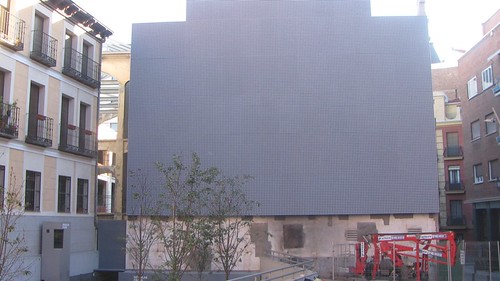
New urban screen, Medialab-Prado
The screen is not yet functional, and you can see that it is in a very close-quarters situation. It will be interesting to see how Medialab-Prado uses this new “venue” with its commitment to open platforms and process.
Medialab-Prado is on a quiet street between the Prado and Reina Sofia museums, around the corner from a new and quite beautiful Caixa Forum center, which includes a different kind of urban screen, what zelen.bg, the “portal site for gardening in Bulgaria,” calls the “last vertical garden of Patrick Blanc.” It’s stunning and forms a fascinating bookend with the new Medialab-Prado screen.
Crystal Mesh
CRYSTAL MESH from autokolor on Vimeo.
Ars Electronica.3
5 September 2009
It rained Friday in Linz, so it was a good day to go indoors. I headed for the new Ars Electronica Center for my longest visit so far. The glass and steel extension to the original building, designed by Treusch Architecture of Vienna, was opened earlier this year. Inside the building are extensive exhibition areas for contemporary and historical new media work. The Future Lab facilities contain laboratories and workshops for media art research, with offices and recreation rooms above. The main building also has a restaurant, bar and lecture rooms on its Sky Deck.
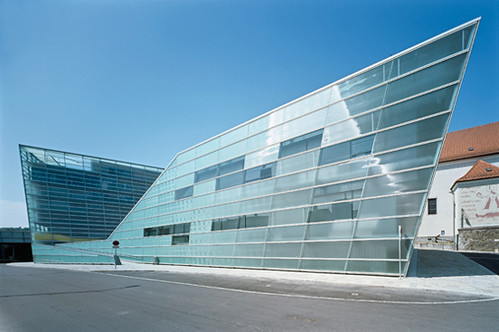
Ars Electronica Center. Photo: Rupert Steiner
The Ars Electronica Center has a sculptural presence. It is meant to be viewed at various distances from diverse vantage points and is easy to traverse on foot. Set alongside the Danube River, its shape evokes a cargo ship. The long prow serves as a public performance or gathering space with raked stairs for seating. The building’s overall grid of glass and its double facade give it a crystalline appearance.

Ars Electronica Center, Linz, Austria. Photo: Bruce Charlesworth
The glass exterior is part transparent and part translucent. At night, LED panels installed between the two layers of the facade illuminate the building. Each panel contains nine sets of four LEDs: red, green, blue and white. These are set vertically, one in each window, alternately facing left and right. Each window functions much like a pixel in a digital image and can be individually controlled to allow infinite variations in color, intensity and duration.
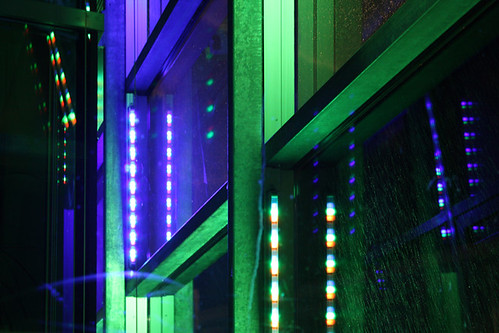
Ars Electronica Center, Linz, Austria. Photo: Bruce Charlesworth
I attended a lecture on the facade and learned that there are 40,000 LEDS, 2,000 meters of cable and 5,100 square meters of glass comprising 1,085 windows. An average window contains 36 LEDs. The building also has a powerful sound system.

Ars Electronica Center, Linz, Austria. Photo: Bruce Charlesworth
Both sound and lighting can be programmed to create unique artworks on the facade, utilizing blended color, patterns, text and imagery. 84 artists have already created programs for the building, only three of which were commissioned works. AEC makes proposing and designing for the building fairly easy. Artists can construct their work using a 3D rendering of the facade, available on the Center’s Future Lab website, without ever having to visit the site in Linz.
Here’s a test visualization of the building lighting done last year.
The new Ars Electronica Center
I’m looking forward to Ars Electronica this coming fall now that the new Center is open.
“The new Ars Electronica Center is a one-of-a-kind facility. Its uniqueness is betokened by its external form. This bold architectural statement is an instant highlight within the Linz cityscape’s ensemble, yet it still sets itself apart at first—none of its edges run parallel, everything appears skewed, elements simultaneously pulling apart and merging together. A structure that’s constantly assuming new forms depending on the perspective from which it’s viewed. And one that withholds revelation of its scope and dimensions until the moment of direct physical encounter.
“More than 5000m2 of glass facade covering the new Ars Electronica Center was assembled with 1,100 LED light strips (RGBW – Red, Green, Blue and White High Power LED`s) . Each of the approximately 4,400 channels (depending 4 Channel light bar) is individually adressable and adjustable between 0-100%. Imagery from patterns to homogeneous color surfaces are possible.”
Mapping architectural facades made easy(web)
via It’s Tea
“3D Mapping Video projected creates a single event using the innovativing system that consists in applying video onto a monumental architecture or object playing with its forms and its volumes.”
http://www.easyweb.fr/indexenglish.html
I guess the lack of information, at least in English, is intended to make the potential client think it is magic that only Easyweb can deploy, and not think about the erasure of message into style, especially when compared to its its pioneering antecedents (which look oddly familiar), or how soon the technology will become commonplace and/or replaced by the next next thing.
Still, it’s cool.












